If there's one baking skill that you'll want to add to your repertoire for the Fall and holiday seasons, it is how to make pumpkin puree from scratch. From decadent desserts and pumpkin spice lattes to savory sides and creamy soups, pumpkin puree can truly make a difference on your holiday dinner menu. And while canned pumpkin puree is just as useful, it may not always be at your fingertips right before Thanksgiving dinner.
Below I'll share a delicious and easy alternative to canned pumpkin puree so you'll have everything you need to make that delightful holiday pumpkin pie at any time and place. Not to mention, there's nothing quite as pleasant as the smell it'll bring to your kitchen! If you ever wondered how to make fresh pumpkin puree, continue reading!
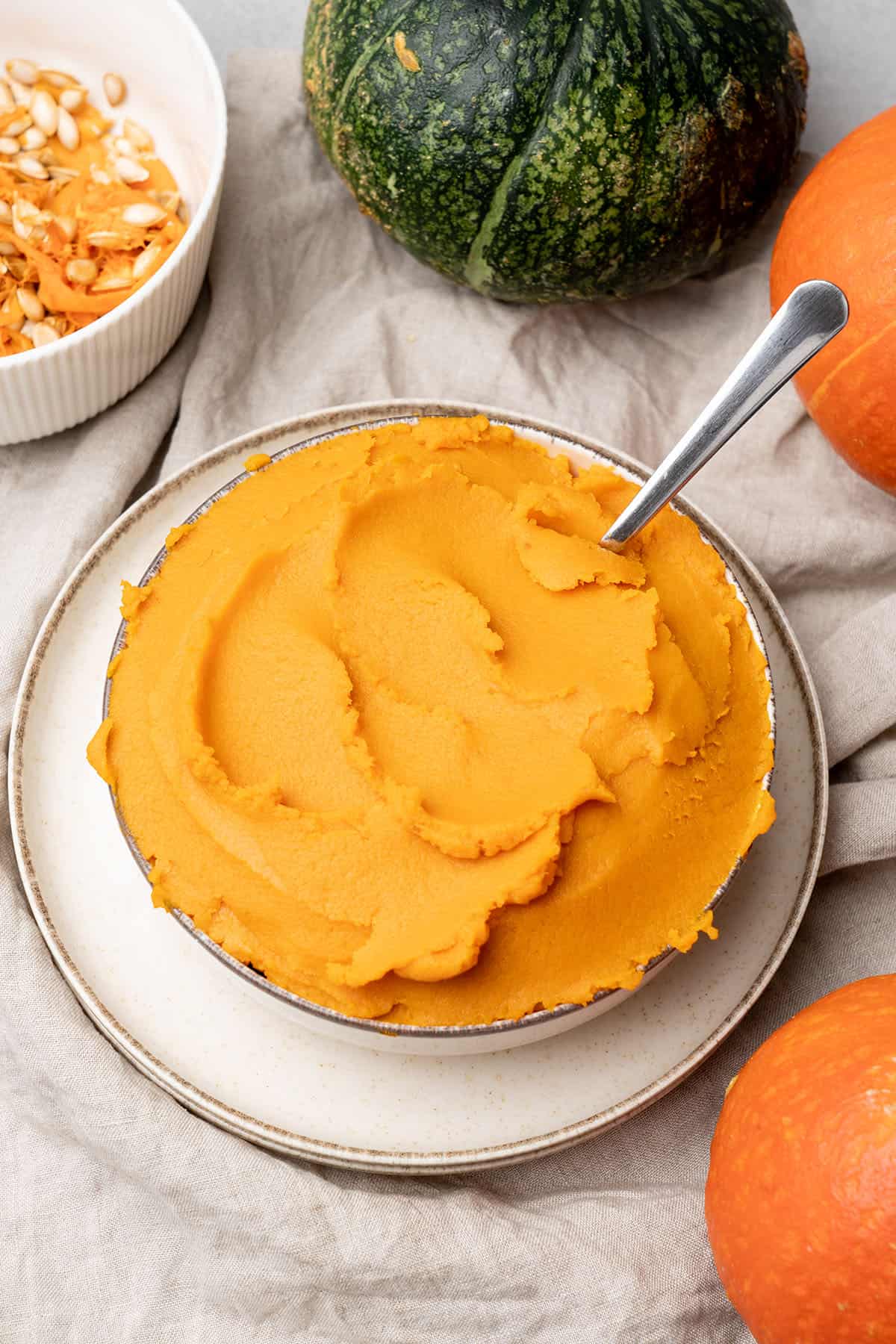
the best pumpkin pie puree from scratch
Jump to:
- 📖 How is canned pumpkin puree made?
- 🌟 Why make pumpkin puree from scratch
- 📖 What kind of pumpkin is used for puree?
- 📖 How to tell if a pumpkin is ripe?
- 📝 Ingredient notes for DYI pumpkin puree
- 👩🍳 How to roast pumpkin in the oven and make homemade pumpkin puree
- 👩🍳 How to make pumpkin puree without oven
- 💡 Should I drain my pumpkin puree?
- 📓 Flavor variations
- 🥣 Equipment Notes
- 🎓 Expert tips
- ❓Recipe FAQs
- 🎃 Pumpkin recipes
- How to make pumpkin puree from scratch
📖 How is canned pumpkin puree made?
If you think all canned pumpkin puree brands are just a pureed version of that bright orange mini pumpkin you see at the pumpkin patch or that big Halloween Jack O' Lantern on your doorstep, think again. Many popular canned pumpkin puree brands are made by steaming and pureeing a combination of winter pumpkin-like squash!
The most popular pumpkin puree brands, such as Libby's 100% Pure Pumpkin and Green Valley Organics Pumpkin use the Dickinson pumpkin, a member of the Cucurbita moschata family of squash. It is one of the closest varieties to the butternut squash. In fact, butternut squash puree is a common substitute for pumpkin puree.
The type of pumpkin used when making the puree will determine its color, taste, and consistency. But no matter what kind of pumpkin or squash is used, a real pumpkin puree has no ingredients or spices added.
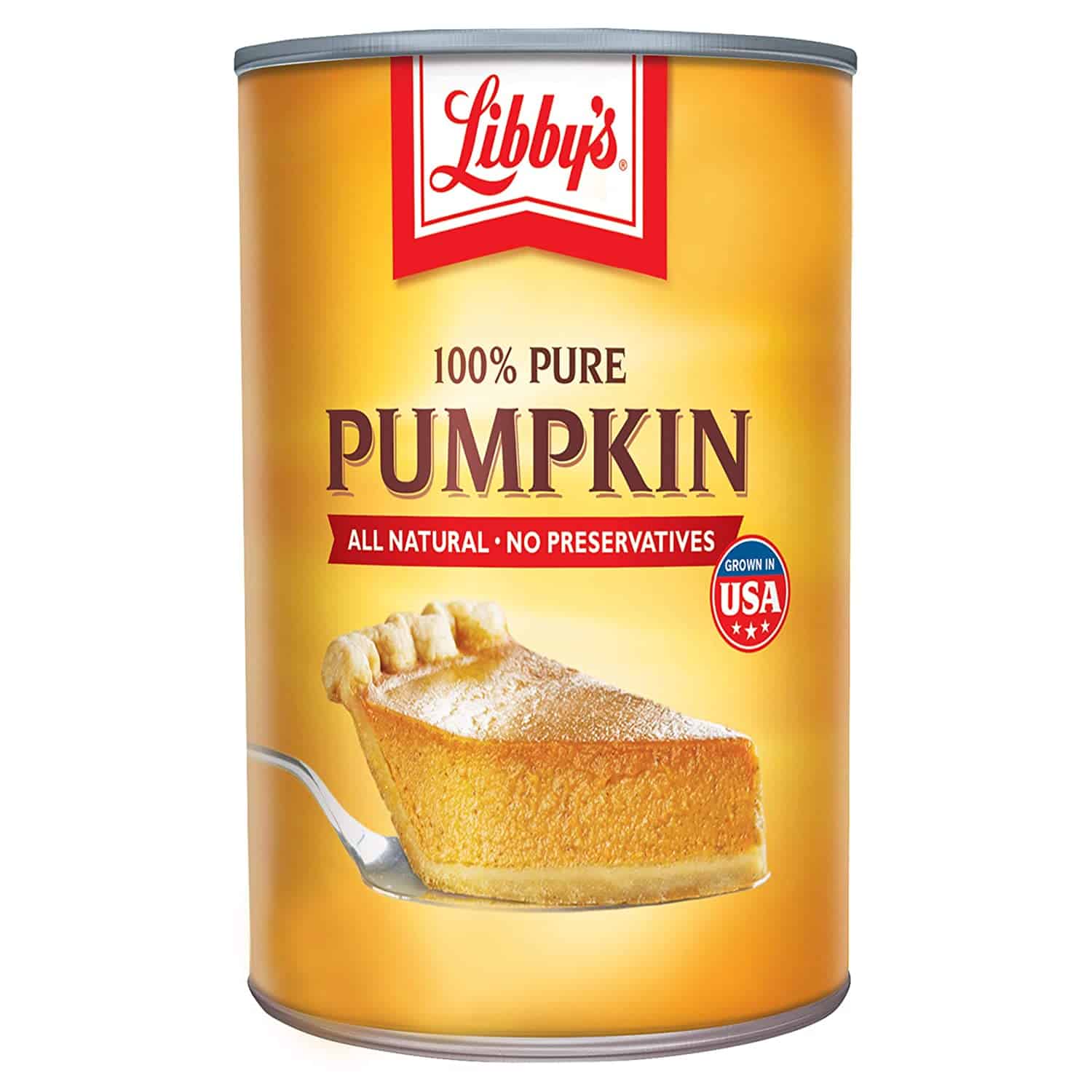
🌟 Why make pumpkin puree from scratch
- It's versatile - When you learn how to make pumpkin puree from scratch, you open the door to many roasted pumpkin recipes, including desserts, soups, pasta, and side dishes! This is also a super easy pumpkin puree recipe with all the details you need to know to succeed!
- It's always available - The canned version of pumpkin puree is a very popular shopping list item over the fall and winter holidays and is prone to sell out. Furthermore, depending on where you live, the canned version may not be available at all! However, when you make your own pumpkin puree for Pumpkin pie, it will always be available to you (not to mention it is a breeze to make).
- You are in control of the taste - Homemade versions give you complete control of what goes in your pumpkin puree such as what kind(s) of pumpkin you use, and ensure that there are no additives.
- It tastes better - No matter what food it is, a fresh, homemade version tastes 100x better than a canned version. Fresh, concentrated pumpkin puree provides a much smoother texture than canned substitutes do.
- It smells better - Opening up a can of pumpkin puree doesn't give you that warm, nostalgic smell like freshly baked pumpkins. Your kitchen will smell absolutely delightful!
- It feels better - There's something about knowing how to make pumpkin puree from fresh pumpkin that feels so good! It's like a heartwarming holiday tradition that you can repeat and pass down from generation to generation.
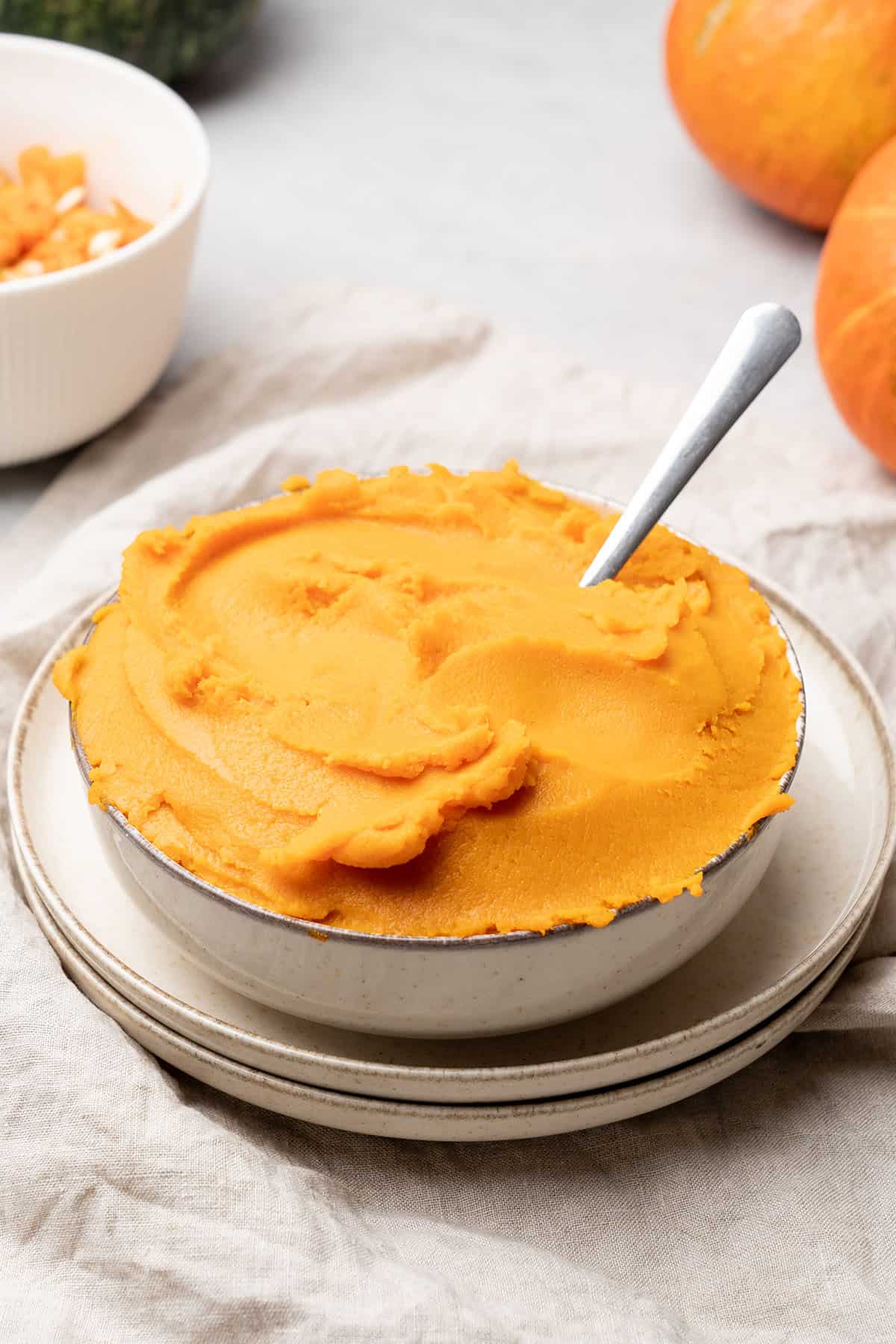
📖 What kind of pumpkin is used for puree?
So wondering how to make pumpkin puree from scratch and what pumpkin to choose? When choosing your own pumpkin for your pumpkin puree, not just any pumpkin will do. The color, flavor, and texture can vary significantly based on the variety of pumpkin you choose, so you want to choose carefully.
For the most flavorful, creamy pumpkin puree, steer clear of that Halloween Jack O' Lantern. Larger pumpkins typically used for carving and decorating tend to pack more water, have lots of stringy fibers and flesh, and are not nearly as sweet.
Instead, you want to look for the smaller, denser sugar pumpkin or pie pumpkin varieties used primarily for baking. They are firm, easy to work with, have less water, and have a naturally sweet taste. Here are a few of the pumpkin varieties you can use as a canned pumpkin puree substitute:
Dickinson - This is the most popular type of pumpkin and is the main ingredient in pumpkin puree brands such as Libby's 100% Pure Pumpkin and Green Valley Organics Pumpkin. It is a medium-to-large pumpkin with a round, elongated shape like butternut squash. It has a smooth, dense texture and a sweet, rich flavor.
Long England Cheese - This variety of pumpkin gets its name from its color and shape, resembling a large cheese wheel. However, the inside reveals a deep orange color. While this is a popular go-to pumpkin for fresh pumpkin puree due to its density and sweet flavor, it is not my favorite. It is too watery and lacks the amount of sweetness I like in a pumpkin puree.
Sweet Sugar Pie - The sugar pie pumpkin is another popular variety for making pies and desserts. It is a small-medium round pumpkin with dark orange skin and meaty orange-yellow flesh. It is a fine choice to make this pumpkin puree
Red kuri - Red kuri squash is a thin skinned orange colored winter squash that an incredibly smooth and creamy texture and very nicely sweet if it is ripe. I recommend using this pumpkin for making this DIY pumpkin pie puree recipe. It is one of the tastiest and does not have as much water as the others.
Butternut Squash - Butternut squash is actually the sweetest option of all, however, provides quite some water. It is a good option to make pumpkin puree for baking but you cannot miss draining the puree before using in recipes.
Small Sugar - This is another pumpkin I recommend for making your fresh pumpkin puree. It is a small, dense pumpkin with a deep-orange color and very sweet-flavored flesh.
Snack Jack - This small, medium-orange pumpkin has a bright orange and flavorful flesh, great for making puree for pumpkin pie. Its seeds are also great for roasting!
Spirit - This orange-gold, medium-large size pumpkin is an excellent all-purpose pumpkin. You can use it to carve, decorate, and puree.
The above are just a few options for making fresh pumpkin puree. Of course, you will want to choose based on your personal taste and expectations.
📖 How to tell if a pumpkin is ripe?
There are a couple of clear signs that tell you whether a pumpkin is ripe or not. However, there is also a difference in whether pumpkin is ripe enough for making pumpkin puree versus ripe enough to use for decoration.
In general, a pumpkin that is ripe enough to use is fully-colored and firm. If you knock on it, it should sound solid on the inside versus hollow. Firmness is essential, as a pumpkin that is too soft will shrivel very quickly.
If you use the pumpkin for cooking versus solely for decorating, it won't need to be as fully-colored or firm since you will puree it. This is especially the case for pumpkins you plan to puree within the next week.
📝 Ingredient notes for DYI pumpkin puree

- Pumpkin - For my pumpkin puree, it is best to use a combination of pumpkin and butternut squash for a more full-bodied flavor. To get the equivalent of approximately two Libby's pumpkin puree cans (roughly 900g concentrated after draining), you will need 2-3 medium-sized pumpkins and 2-3 butternut squashes. While the butternut squash is very sweet, it can also be a little watery and you will need to drain it. Or, use Red kuri pumpkin only that has a wonderful taste and is not too watery.
- Water (Optional) - You may need a small dash of water to loosen up the puree. However, in many cases, the pumpkin or squash has too much water and you will need to drain it. You will have to make this call depending on the pumpkins you are using
🛒 You’ll find detailed measurements for all ingredients in the printable version of the Recipe Card at the bottom of this post
👩🍳 How to roast pumpkin in the oven and make homemade pumpkin puree
So let´s see how to make pumpkin puree from fresh pumpkin!
- To start, preheat your oven to 200C / 392F. For the most accurate temperature, use a digital oven thermometer.
- Thoroughly clean your pumpkin and butternut squash. Next, chop each into half vertically and remove the seeds.
- Place the cleaned, cut pumpkin halves onto a baking sheet or sheet pan. Depending on the size of your oven, you may need 2-3 baking sheets to fit all of your pumpkin halves. To prevent the puree from browning, make sure that you place them with the skin facing up.
- After approximately one hour, use a fork to check the texture. If the pumpkin halves are soft, you can consider them done.
- Once your pumpkin is soft, remove them from the oven and let them cool on the baking sheet.
- Once the pumpkin halves have cooled, remove the skin and mash the pumpkin with a blender or a food processor. Once it becomes a smooth puree, it is done. Drain any extra liquid left on top, if necessary.
- Use the puree as indicated in the recipe, or store it in an airtight container for up to 3-5 days for the best quality.
💡 Top Tip: If your pumpkin puree is too watery, use a cheesecloth or kitchen towel to eliminate some of the liquid. On the other hand, if your puree is on the dry side, you can always add a dash of water to loosen it up.

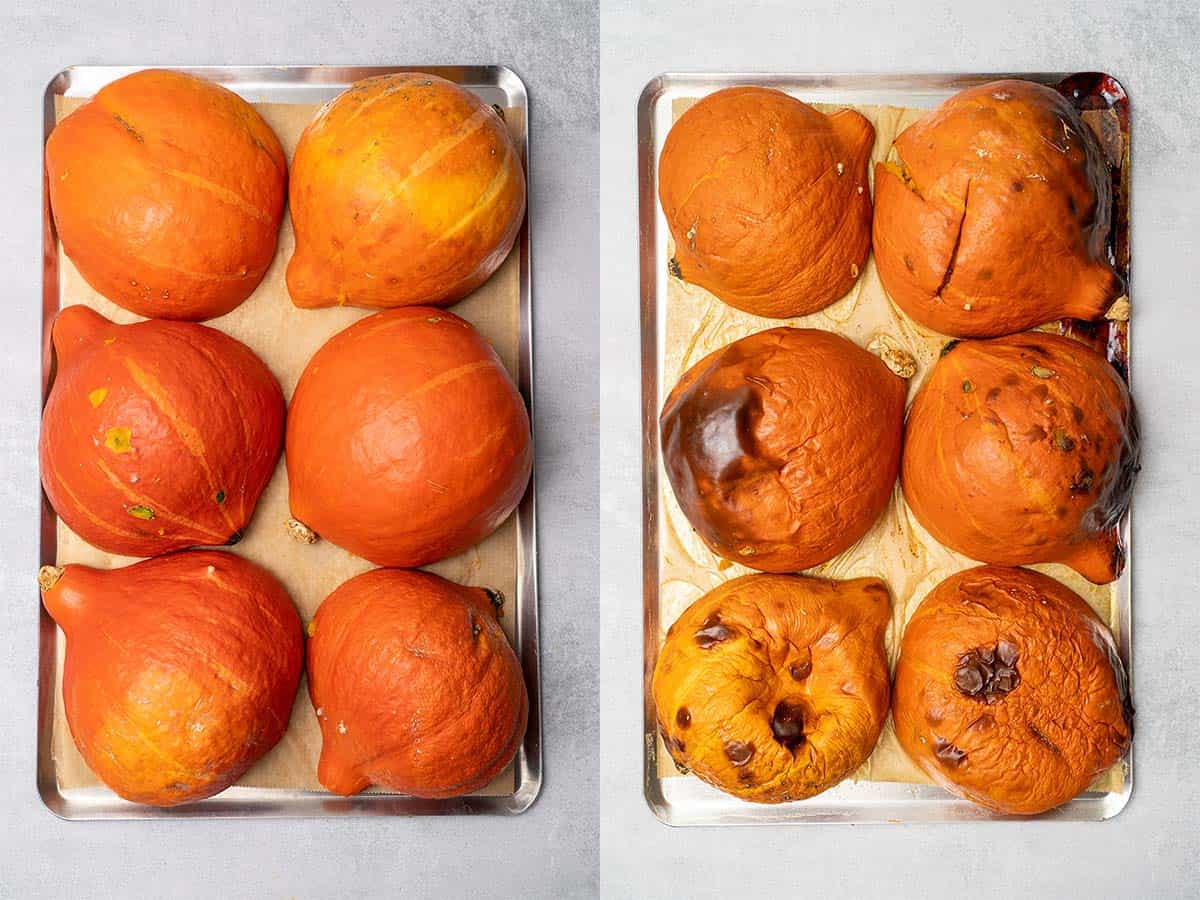

👩🍳 How to make pumpkin puree without oven
An oven is ideal for making pumpkin puree since it helps evaporate the extra water that develops. However, you can still make pumpkin puree at home even if you don't have access to an oven. Steaming and boiling are also acceptable ways to make pumpkin puree from scratch.
To steam the pumpkin, you would first cut your pumpkin into smaller pieces, remove the skin, and steam them until they are tender enough to cut with a fork. Steaming can take up to 30-40 minutes. Once soft, let the pumpkin cool down, and air out until the steam is gone. Then, continue mashing the pumpkin until thoroughly pureed.
To boil the pumpkin, first, cut your pumpkin into smaller pieces, remove the skin, and place it in a large saucepan with water. Bring it to a boil and cook the pumpkin for 15-20 minutes until it is soft enough to cut with a fork. Then, remove the pieces from the water and let them cool completely before moving on to mashing and pureeing. Out of the three methods, boiling creates more water and is even more critical to drain.
💡 Top Tip: Cut your pumpkin into smaller pieces to speed up the steaming or boiling process. The pumpkin cooks faster when in small pieces versus larger chunks.
💡 Should I drain my pumpkin puree?
If you are using your pumpkin puree for baking, a thick and creamy puree is key. Therefore, draining the water is a necessary step not just in case of this homemade pumpkin puree recipe but also, if you buy canned pumpkin puree that is more on the watery side. Removing the water doesn't just improve the consistency and texture of the puree. It also immensely intensifies its taste.
You can drain the water from your pumpkin puree using a cheesecloth, a sieve, or by cooking the puree to evaporate the water.
The only time when draining all of the water out of your pumpkin puree is less critical is when making soup.
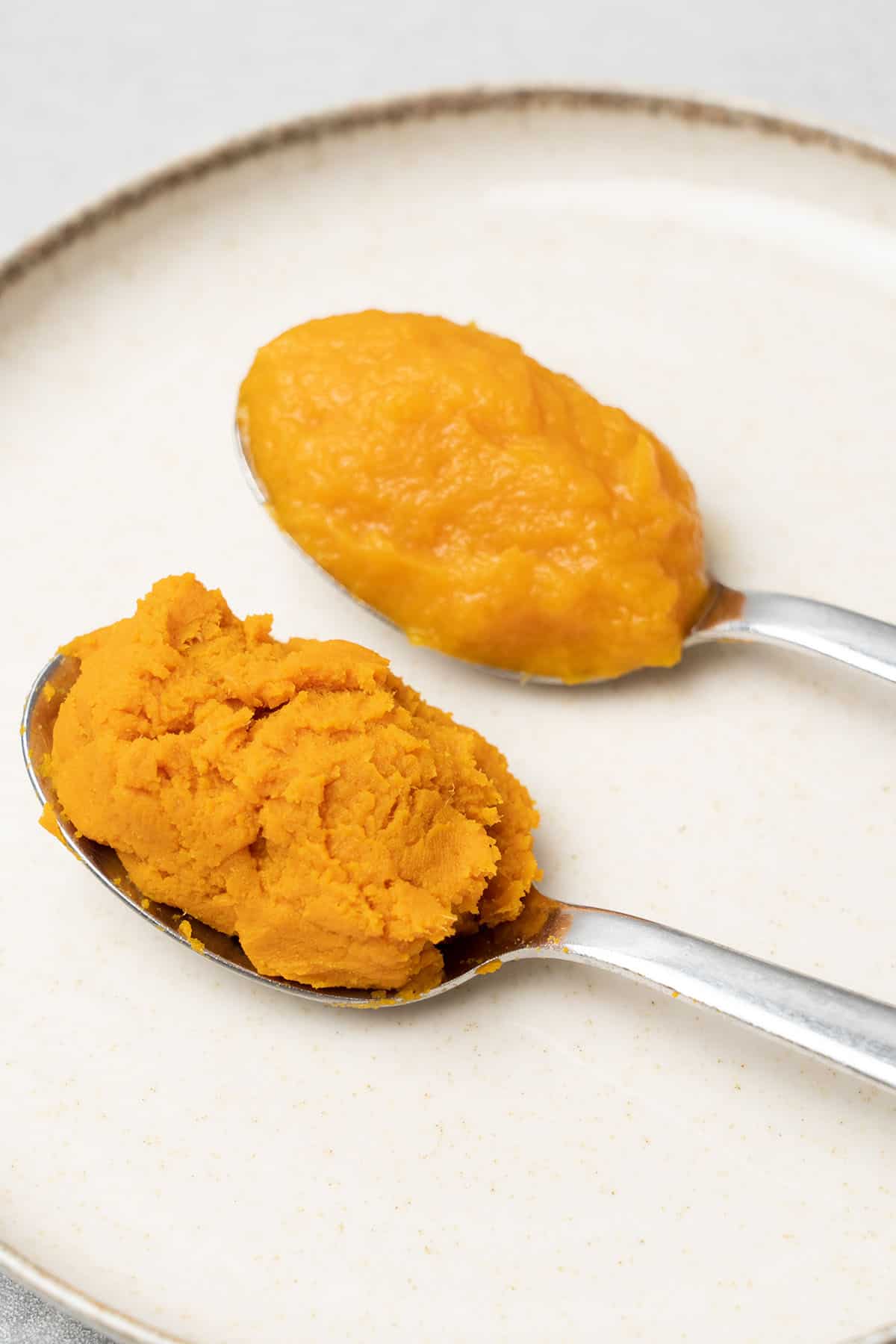
📓 Flavor variations
Depending on how you plan to use your pumpkin puree, you can mix it with other spices and seasonings for an extra flavor boost!
If using the puree for a pie or other baked goods, you can stir in your own homemade pumpkin spice mix with cinnamon, nutmeg, brown sugar, or cloves for a sweet and delicious variation. Another option is to add 2 tablespoons of honey to the drained pumpkin before placing it in the blender or food processor.
Vanilla bean, orange zest, and cardamom are all wonderful additions to your pumpkin puree if used in sweet dessert recipes.
You can also stir in seasonings such as rosemary or salt and pepper if using your puree for savory dishes such as soup or as an alternative to your typical mashed potatoes.
🥣 Equipment Notes
How to puree pumpkin? There are several different ways that you can puree your pumpkin. Some work better than others. A food processor is the best tool to turn it into a smooth puree.
However, a high-speed blender will just as easily do the trick if you don't have a food processor. Just blend until smooth and creamy.
If you don't have either of the above, you can use a fork, wooden spoon, or potato masher. However, it will be very time-consuming, labor-intensive, and won't get your puree as smooth as a food processor or blender.
No matter what tool you use to puree your pumpkin, you will still need a cheesecloth or kitchen towel, or a sieve to drain the water.
Depending on the size of your oven, you may need multiple baking sheets to fit and bake all of your pumpkin halves.
Finally, a digital oven thermometer is always helpful to ensure you don't over or undercook the pumpkin. Ovens can vary by a few degrees, but a thermometer will ensure you have the right temperature.
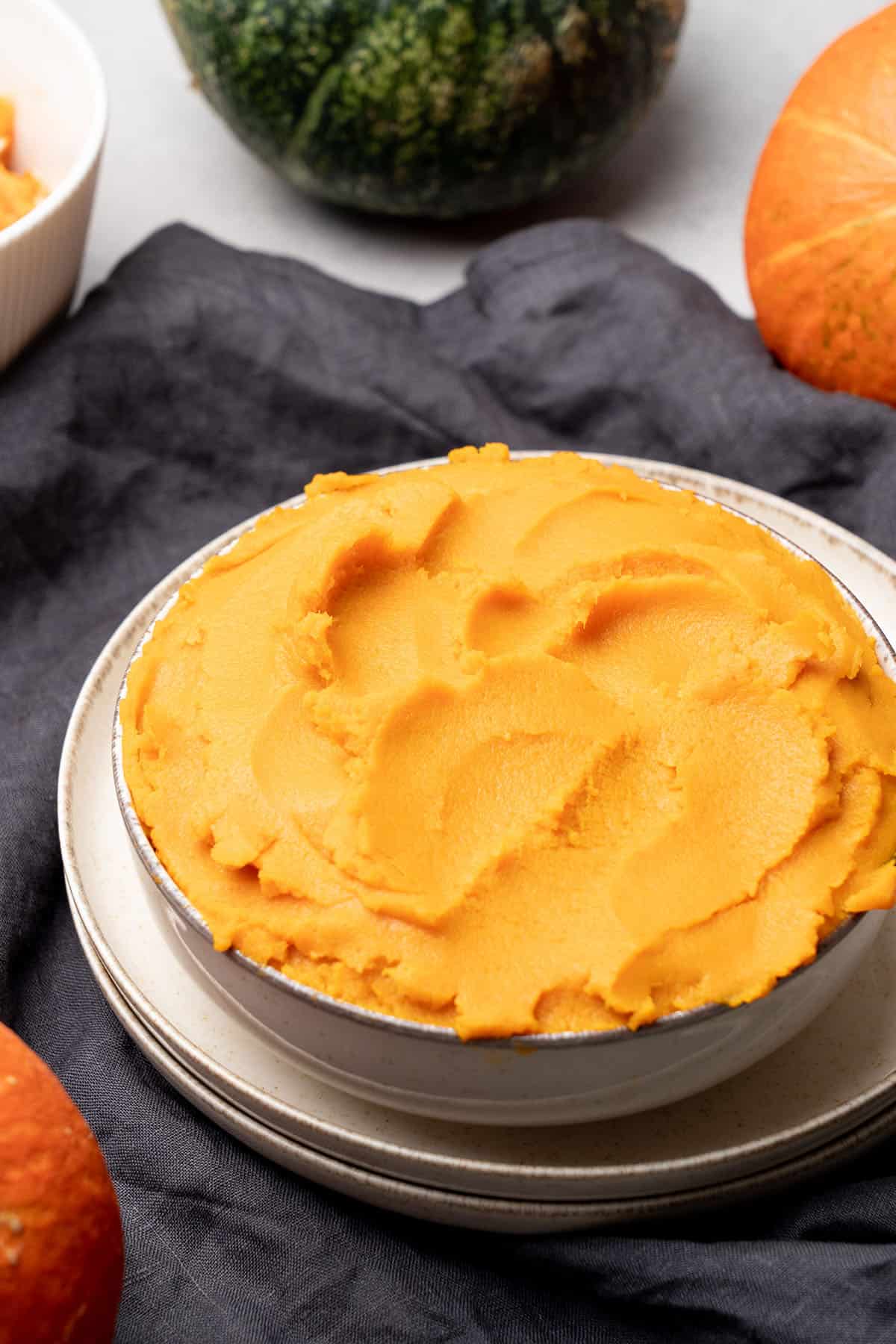
🎓 Expert tips
- To test for ripeness, use your fingernail and run it across the skin. If it can easily pierce or create an indentation, it isn't yet ripe enough to harvest. If it does not puncture the skin, it is a sign that it is ripe enough to use.
- For best results, line your baking sheets with parchment paper before placing the pumpkin halves on them.
- Always place your pumpkin in the oven skin side up to prevent browning and caramelization of your pumpkin. You want your puree to keep a bright orange color.
- After an hour of baking, use a fork to check for softness. If it isn't soft enough to pierce with a fork, it isn't done. Let it cook for a little longer.
- If using a fork, wooden spoon, or potato masher to mash the pumpkin, first cut the pumpkin into smaller pieces. Doing so will make the mashing process much easier.
- When steaming or boiling the pumpkin, cutting the pumpkin into smaller pieces also helps to speed up the softening process.

❓Recipe FAQs
While a food processor is probably the easiest way to make pumpkin puree, it isn't absolutely necessary. You can also use a blender, potato masher, wooden spoon, or fork to mash the pumpkin until it becomes a smooth puree. However, the latter options are not recommended because achieving the right consistency is very labor-intensive and time-consuming. If you do so by hand, it is easiest if you first cut your pumpkin into small pieces.
Real pumpkin puree and canned pumpkin puree are made with 100% cooked pumpkin and contain no added ingredients. On the other hand, pumpkin pie filling contains pumpkin puree and various spices and sweeteners to give the pie its delicious flavor.
Pumpkin pie filling can be used for a variety of sweet and savory recipes, meanwhile pumpkin pie filling is usually reserved for pies and other baked desserts. While pumpkin pie puree can be used as a substitute for pumpkin pie filling, pumpkin pie filling can not always be used as a pumpkin puree substitute in baking.
You can use your homemade pumpkin puree to make many delicious sweet treats! Some of my favorite fresh pumpkin puree recipes include classic pumpkin pie, pumpkin bread, pumpkin bundt cake, pumpkin cheesecake, and pumpkin muffins. You can also use pumpkin puree to make a creamy pumpkin spice latte or savory dishes such as pumpkin puree soup and risotto. At the bottom of this page, I share several pumpkin recipes that also use pumpkin puree.
If not using your pumpkin puree immediately, place it in an airtight container in the refrigerator or freezer. It will keep the best quality for 3-5 days in the fridge and up to 6 months in the freezer.
Absolutely! Pumpkin pie puree can also be frozen and used later down the line when you are ready. The best way to freeze pumpkin puree is by dividing it into smaller batches and placed into airtight containers or re-sealable plastic bags. You can even freeze them in an ice cube tray.
To thaw your pumpkin puree, place it in the refrigerator overnight and then use it within three days. Or, if you need it immediately, you can soak the container or plastic bag in warm water for an hour or place it under lukewarm running water. If you choose to defrost your pumpkin puree under water or on the counter, you will want to use it within 24 hours.
If stored properly in the refrigerator in an airtight container, your pureed pumpkin will last up to a week. If stored in the freezer, it will last for months. However, for the best taste, I don't recommend keeping it in the refrigerator for more than five days or more than six months in the freezer.
Just like a whole pumpkin, pumpkin puree can ferment and rise like dough if not stored properly. Signs of a pumpkin puree going bad include a foul smell, sour taste, separation, and mold growth. If you see any signs of mold, it is best to throw the entire container away to be safe, as it can make you sick.
Don't be so quick to throw out those pumpkin seeds after you make pumpkin puree from fresh pumpkin! Pumpkin seeds are full of fiber (especially when eaten with the shell). Make crispy air fryer pumpkin seeds and sprinkle them with spices or put them in the oven for delicious roasted pumpkin seeds. Or, you can eat them raw. They can also be used in salads, baked into cookies, or planted to grow new pumpkins!
Yes. Pumpkin is a naturally gluten free and vegan food. As long as the canned pumpkin puree contains 100% pumpkin, it will also be gluten free and vegan.
While pureed sweet potatoes have a slightly different taste than pumpkin puree, their texture and color are similar and can be used as a fresh pumpkin or canned pumpkin substitute. Simply drain the sweet potatoes and used them in the same proportion.
🎃 Pumpkin recipes

How to make pumpkin puree from scratch
Ingredients
- 5 medium sized Pumpkin pumpkin of your choice eg. butternut squash, dickinson, sweet sugar pie, red kuri
US customary cup measurement is an indicative figure only. Measure the ingredients with a digital scale by weight (gram). Baking is art but also science which requires precision and accuracy.
Instructions
- Pre-heat oven to 200C / 392F.
- Clean a mix of pumpkins and butternut squashes, chop them into half vertically, and take remove the seeds.
- Place the cut pumpkin halves into 2-3 trays on a baking sheet with the skin facing up.
- Bake the pumpkin for approximately one hour. Check with a fork whether they are done - they should be soft within an hour.
- Let the pumpkin halves cool in the baking tray, then take the skin off and mash them with a blender or food processor until it becomes a smooth puree.
- Depending on how watery your pumpkins are you probably want to strain the puree on cheesecloth to get rid of some of the liquid. Concentrated pumpkin puree provides a smoother texture and better taste on your baked goods.
- Store the puree in an airtight container in the refrigerator for 3-5 days maximum or use it according to the recipe.


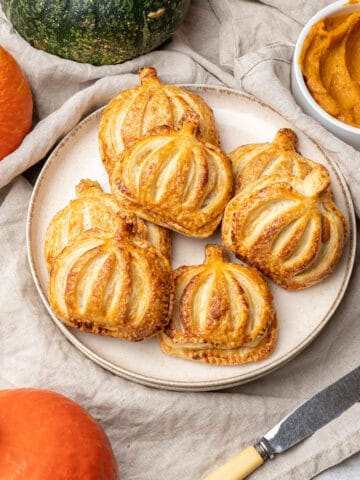

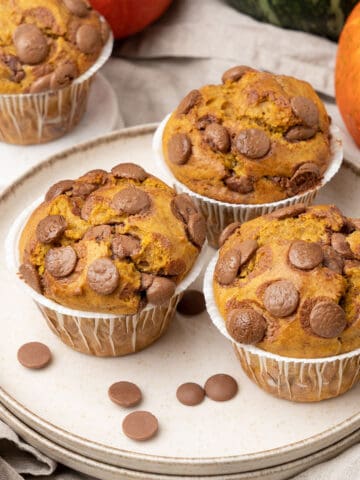
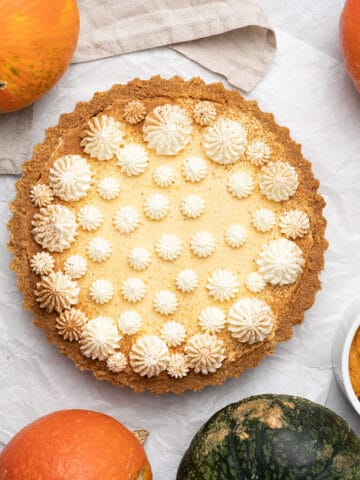
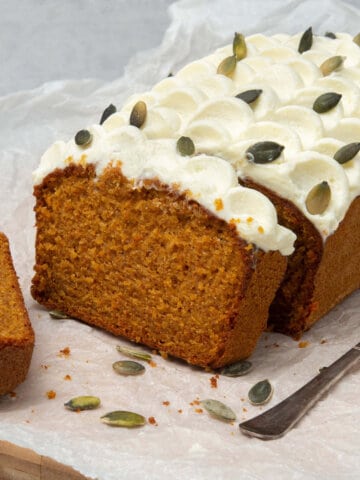



Leave a Reply